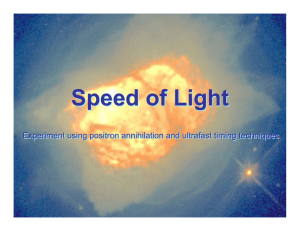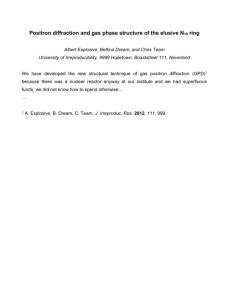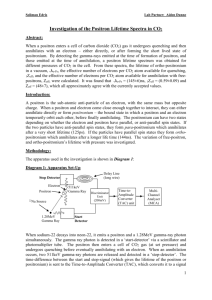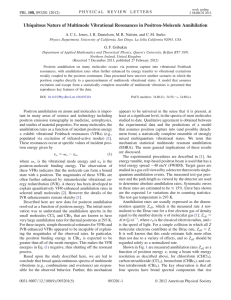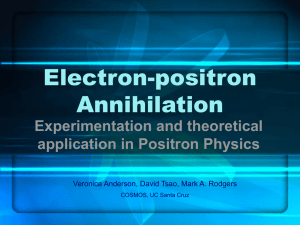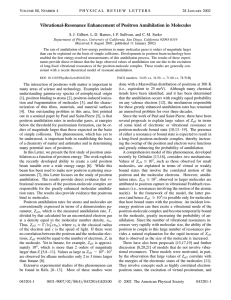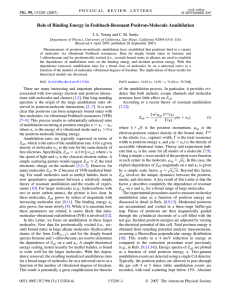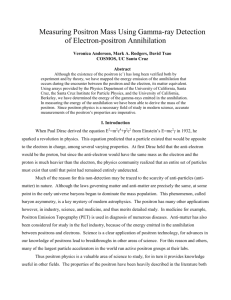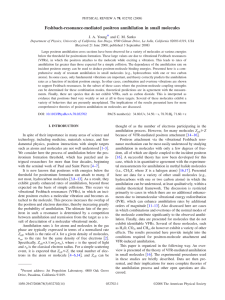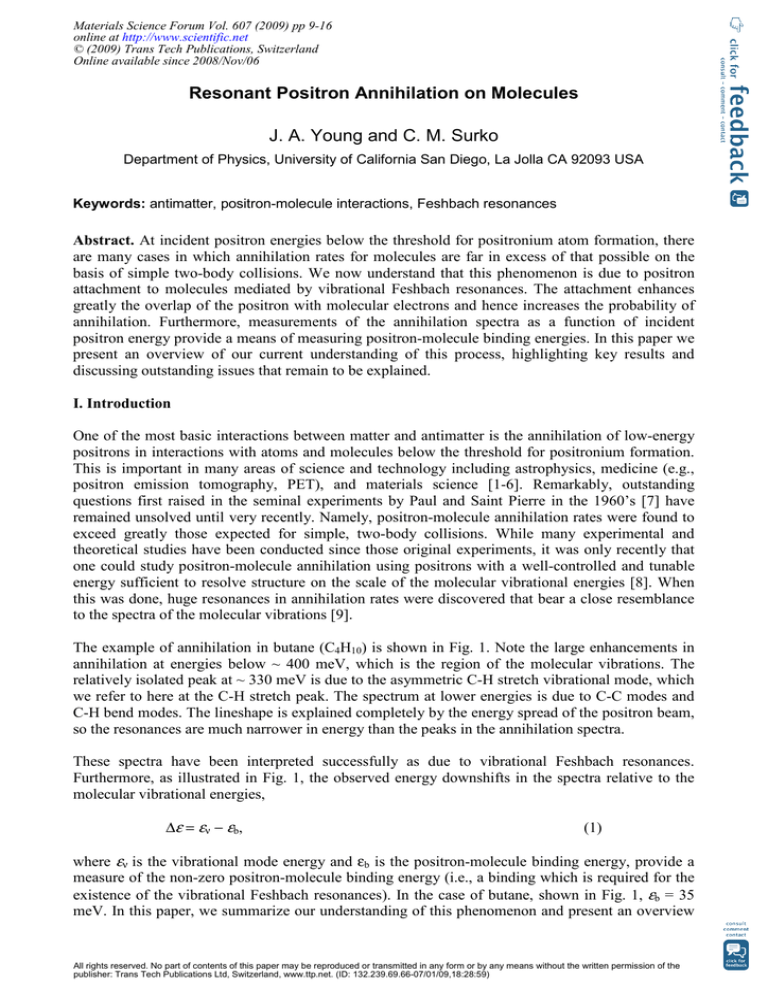
Materials Science Forum Vol. 607 (2009) pp 9-16
online at http://www.scientific.net
© (2009) Trans Tech Publications, Switzerland
Online available since 2008/Nov/06
Resonant Positron Annihilation on Molecules
J. A. Young and C. M. Surko
Department of Physics, University of California San Diego, La Jolla CA 92093 USA
Keywords: antimatter, positron-molecule interactions, Feshbach resonances
Abstract. At incident positron energies below the threshold for positronium atom formation, there
are many cases in which annihilation rates for molecules are far in excess of that possible on the
basis of simple two-body collisions. We now understand that this phenomenon is due to positron
attachment to molecules mediated by vibrational Feshbach resonances. The attachment enhances
greatly the overlap of the positron with molecular electrons and hence increases the probability of
annihilation. Furthermore, measurements of the annihilation spectra as a function of incident
positron energy provide a means of measuring positron-molecule binding energies. In this paper we
present an overview of our current understanding of this process, highlighting key results and
discussing outstanding issues that remain to be explained.
I. Introduction
One of the most basic interactions between matter and antimatter is the annihilation of low-energy
positrons in interactions with atoms and molecules below the threshold for positronium formation.
This is important in many areas of science and technology including astrophysics, medicine (e.g.,
positron emission tomography, PET), and materials science [1-6]. Remarkably, outstanding
questions first raised in the seminal experiments by Paul and Saint Pierre in the 1960’s [7] have
remained unsolved until very recently. Namely, positron-molecule annihilation rates were found to
exceed greatly those expected for simple, two-body collisions. While many experimental and
theoretical studies have been conducted since those original experiments, it was only recently that
one could study positron-molecule annihilation using positrons with a well-controlled and tunable
energy sufficient to resolve structure on the scale of the molecular vibrational energies [8]. When
this was done, huge resonances in annihilation rates were discovered that bear a close resemblance
to the spectra of the molecular vibrations [9].
The example of annihilation in butane (C4H10) is shown in Fig. 1. Note the large enhancements in
annihilation at energies below ~ 400 meV, which is the region of the molecular vibrations. The
relatively isolated peak at ~ 330 meV is due to the asymmetric C-H stretch vibrational mode, which
we refer to here at the C-H stretch peak. The spectrum at lower energies is due to C-C modes and
C-H bend modes. The lineshape is explained completely by the energy spread of the positron beam,
so the resonances are much narrower in energy than the peaks in the annihilation spectra.
These spectra have been interpreted successfully as due to vibrational Feshbach resonances.
Furthermore, as illustrated in Fig. 1, the observed energy downshifts in the spectra relative to the
molecular vibrational energies,
∆ε = εν − εb,
(1)
where εν is the vibrational mode energy and εb is the positron-molecule binding energy, provide a
measure of the non-zero positron-molecule binding energy (i.e., a binding which is required for the
existence of the vibrational Feshbach resonances). In the case of butane, shown in Fig. 1, εb = 35
meV. In this paper, we summarize our understanding of this phenomenon and present an overview
All rights reserved. No part of contents of this paper may be reproduced or transmitted in any form or by any means without the written permission of the
publisher: Trans Tech Publications Ltd, Switzerland, www.ttp.net. (ID: 132.239.69.66-07/01/09,18:28:59)
10
Positron and Positronium Chemistry
of the positron-molecule binding energies measured to date. We also discuss outstanding questions
yet to be resolved.
II. Description of the Experiments
The procedures used to measure atomic and molecular annihilation rates as a function of positron
energy have been discussed in detail elsewhere [9, 10]. A schematic of the experimental setup is
shown in Fig. 2. Pulses of positrons from a trap-based cold positron beam are magnetically guided
through the cylindrical electrode of a cell filled with the test gas. Total positron energy is obtained
from retarding potential analyzer measurements of the parallel energy distribution (25 meV,
FWHM), assuming a thermal Maxwellian energy distribution in the plane perpendicular to the
magnetic field with a temperature of 25 meV [11].
Figure 1. (a) annihilation spectrum of butane (C4H10;) as a function of the total incident
positron energy, ε, represented as the normalized quantity, Zeff [defined in Eq. (2) below];
and (b) Zeff on an expanded scale in the region of the molecular vibrations, with (- - ) the
vibrational mode spectrum of butane (in arbitrary units) artificially broadened by 10 meV.
The horizontal arrows indicate Zeff for thermal positrons at 300 K. The vertical arrow in (a)
shows the threshold for positronium formation in butane. Reprinted from Ref. [10].
Energy spectra for Zeff, are plotted as a function of total incident positron energy, ε. As mentioned
above, the widths and shapes of the observed resonances, such as those illustrated in Fig. 1, are
dominated completely by the energy distribution of the incident positron beam. Single quanta from
two-gamma annihilation events are detected using a CsI detector. Absolute values of the
Materials Science Forum Vol. 607
11
annihilation rates are obtained from measurements of the positron pulse strength, the path length,
and the test-gas pressure to within an absolute accuracy of approximately 20%.
Figure 2. Schematic diagram of the experimental setup used to measure positron-molecule
annihilation rates. The key features are a tunable, trap-based positron beam with a parallel
energy spread ~ 25 meV, FWHM, and a similar perpendicular energy spread, and the fact
that the beam is magnetically guided through the gas cell with a field ~ 0.08 tesla. From
Ref. [12]. See text for details.
III. Prototypical Case of Small Molecules – Annihilation in 1-Halomethanes
Annihilation rates are typically expressed in terms of the quantity Zeff, which is the annihilation rate,
λ, normalized to that for a free electron gas, namely
Z eff =
λ
π r 20 cn
,
(2)
m
where r0 is the classical electron radius, c is the speed of light, and nm is the density of the target
atoms or molecules. Thus, the condition Zeff = Z, where Z is the number of electrons in the target,
corresponds to annihilation in an uncorrelated electron gas with electron density n = nmZ. This is, in
fact, much smaller than the rates observed for many molecules interacting with low-energy
positrons. In alkane molecules, for example, Zeff can be ~ 104 – 107. Gribakin and Lee have
developed a successful theory of Feshbach-resonant positron annihilation [11]. According to this
theory, the normalized annihilation rate, Zeff, for the resonant process can be written,
zeff (ε) =
a c
2π
bυ Γυ Γυ ∆(ε − ) ,
ευ
∑
2
r o c υ k υ Γυ
(3)
where bν is the multiplicity of vibrational mode ν; kν is the incident positron momentum at the
energy of resonance ν; Γνa, Γνc, and Γν are respectively the annihilation width, the capture (and
emission) width, and the total width; and ∆(ε) is the energy distribution of the incident positron
beam.
Thus far, the most precise test of this theory is annihilation in the 1-halomethanes, CH3F, CH3Cl,
and CH3Br, and their fully deuterated analogs. The energy spectrum of Zeff for CH3Br is shown in
12
Positron and Positronium Chemistry
Fig. 3. In this and other halomethanes, all of the vibrational modes are dipole coupled to the
incident positron, and so the capture widths, Γc, can be calculated from the Born-dipole
approximation or taken from infrared measurements [11]. Thus all of the parameters in Eq. (3) are
known except for the binding energy, εb. As illustrated in Fig. 1, this quantity can be determined
from experiment by measuring the downshift in the Zeff spectrum relative to that of the vibrational
modes. There is good agreement between the predictions of Eq. (3) and the measured values of Zeff,
both in magnitude of the peaks and in the spectral shapes. This provides a strong validation of the
theory.
Recently, the model was tested further in the deuterated 1-halomethanes [13]. In this case, it is
known from experiments on several molecules that the positron-molecule binding energy does not
change with deuteration. Thus the binding energy taken from the hydrogenated species can be used
to provide absolute theoretical predictions for the case of the deuterated molecules. The results for
CD3Cl and CD3Br (i.e., molecules for which εb is large enough to resolve in experiment) show very
good, absolute agreement between theory and experiment, in this case with no fitted parameters.
The magnitudes of isolated resonances in this model are limited to Zeff ~ 103, ignoring degeneracy.
However, many larger molecules have been shown to exceed this limit by orders of magnitude (c.f.,
Fig 1). Thus there is more to the story, which we discuss in the next section.
Fig. 3. Shown is the Zeff spectrum for CH3Br compared with the predictions of Eq. 3. In this
case, the binding energy, εb is taken from the position of the C-H stretch peak. The resulting
good agreement validates the theoretical predictions. Reprinted from Ref. [11].
IV. Annihilation in Larger Molecules and Evidence for Additional Enhancements
In simple hydrocarbon molecules such as the alkanes (CnH2n+2), experiments show that Zeff
increases exponentially with molecular size (i.e., with n), while the shift in the C-H stretch peak,
which is a measure of the binding energy, increases linearly in proportion to n. Examples are shown
in Fig. 4. Since the peak values exceed greatly those predicted by the single-resonance theory of Eq.
(3) (i.e., Zeff/n > 103), other phenomena must be involved. While presently unproven, it is believed
that, in the case of larger molecules with many modes, the positron attaches to the molecule through
so-called “doorway” resonances (e.g., dipole-allowed vibrational transitions), then these states
couple to other, so called “dark” states that are not coupled to the positron continuum [14]. These
added resonances, in turn, are believed to increase greatly the amplitude of Zeff, due to the fact that
Materials Science Forum Vol. 607
13
the number of accessible modes and mode combinations rises exponentially with molecular size. In
this case, estimates of the density of dark states indicate that, if all were coupled to the doorway
state, a much larger increase of Zeff with n would be evident than that which is observed.
The theory of Gribakin predicts that Zeff should be proportional to g = (εb/ε)1/2, where ε is the energy
of the incident positron. As shown in Fig. 5, when this scaling is normalized out of Zeff, the values
for many molecules lie on a universal curve,
4.1
Z eff /g ∝ N ,
(3)
where is the number of atoms in the molecule. We interpret this to mean that Zeff increases
approximately as the fourth power of the number of vibrational degrees of freedom. The key point
is that no additional dependence of Zeff on positron-molecule binding energy is observed beyond
that represented by the factor g.
Fig. 4. Zeff spectra for the selected alkane molecules, C4H10, C9H20 and C12H26. The large
peak is the C-H stretch mode which has an energy εν ≈ 370 meV. Note the large increase in
Zeff with molecular size going from C4H10 and C12H2. This rapid increase with molecular
size is common to all of the alkane measurements. Data from Refs. [10, 15].
In the spectra for C14H30 and C16H34, peaks downshifted by 50 and 100 meV, respectively, have
been identified as second (i.e., “positronically excited”) bound states, mediated by excitation of the
C-H stretch vibrational mode [16]. The intensities of these peaks, relative to those of the C-H
resonances for the positron ground states, also obey the g scaling. This scaling with g indicates that
inelastic escape channels are generally inoperative [15, 16]. Namely, for more shallowly bound
states, more modes could eject the bound positron, and the values of Zeff would be lower than that
which is observed. This contradicts the data, so we conclude that inelastic escape channels are
generally inoperative. We note for completeness that there is, in fact, evidence of an operative
14
Positron and Positronium Chemistry
inelastic escape channel – the case of the partially fluorinated alkanes [16]. This is not unexpected
since vibrational excitation measurements indicate that the positron couples very strongly to the C-F
bond [17].
At least one key open question remains in explaining the very large Zeff values that are observed in
large molecules. If all of the positrons that attached to molecules and populated the dark states
remained attached (e.g., occupying the available dark states statistically), then Zeff values would
actually be roughly comparable (or at least Zeff would increase only slowly as a function of
molecular size) for the wide variety of molecules studied. This again contradicts the data. This is
the limit of our present understanding. We hypothesize that quasielastic escape channels could be
the mechanism that controls Zeff, but this has yet to be verified.
Fig. 5. Values for Zeff at the C-H stretch peak, scaled by the factor g = (εb/ε)1/2, as a function
of the total number of atoms in the molecule, (i.e., interpreted physically as the number of
vibrational degrees of freedom) for various species. Alkanes (CnH2n+2), shown as open
squares, are marked by the number, n, of carbon atoms in the chain. The solid line is a fit to
the data of the form Z eff ∝ N 4.1 . From Ref. [15].
V. Positron-molecule Binding Energies
Through experiments such as those described above, we now have measurements of
positron-molecule binding energies for approximately thirty compounds [16]. Another five or so are
known to have positive binding energies (i.e., since they exhibit Feshbach resonances), but εb is too
small to measure. Examples given in Table I show a broad range of values, from C2H6 and CH3F,
whose binding energies are too small to resolve accurately to C16H34 which has a binding energy of
310 meV and a second (positronically excited) bound state. The ground-state binding energy of
napthelene is similar, but it has no second bound state.
Materials Science Forum Vol. 607
15
Table I. Positron binding energies (in meV) and Zeff at the C-H stretch peak
for selected molecules, with and Z the numbers of atoms and molecular
electrons, respectively. The notation “≥0” denotes non-zero binding energies
too small to measure. Only relative Zeff values are available for hexadecane,
which is indicated by the arbitrary factor ‘x.’ Data from Refs. [16, 18].
Formula
Z
εb
1-fluoromethane
1-bromomethane
CH3F
CH3Br
5
5
18
44
≥0
40
35
820
ethane
butane
octane
dodecane
hexadecane
2nd bound state
C2H6
C4H10
C8H20
C12H26
C16H34
8
14
26
38
50
18
34
66
98
130
≥0
35
115
220
310
100
900
21,000
1,090,000
9,800,000
15x
4x
C6H6
12
42
150
47,000
Molecule
benzene
Zeff
VI. Concluding Remarks
Much progress has been made in understanding positron annihilation on molecules at energies
below the threshold for positronium formation. There is strong evidence for
Feshbach-resonance-mediated attachment. In the case where all modes are dipole-allowed, there is
a successful quantitative theory of the resulting annihilation rates. For larger molecules, the picture
is less clear. It is likely that intramolecular vibrational energy redistribution (IVR) plays an
important role, but at a minimum, the details of this process are lacking.
These experiments highlight the importance of positron binding. While there are accurate
calculations for positron binding to atoms [19], there has been less work in the area of positron
binding to molecules [20-22]. A key challenge for both experimentalists and theorists is to find
molecules for which positron-molecule binding energies can be predicted accurately and studied
experimentally. Likely this will first occur in the case of relatively small molecules where the
theory is more tractable and for ones that have an appreciable vapor pressure at not too high a
temperature, so that they can be studied experimentally.
Acknowledgements
We wish to acknowledge helpful conversations with Gleb Gribakin and James Danielson and the
expert technical assistance of Gene Jerzewski. This work is supported by the U. S. National Science
Foundation, grant PHY 02-44653.
References
1.
2.
3.
P. A. Milne, Distribution of positron annihilation radiation New Astronomy Reviews,
Astronomy with Radioactivities. 50, 548-552 (2006).
N. Prantzos, New Astronomy Reviews, Astronomy and Radioactivities, V, 553-556 (2006).
S. Sazonov, E. Churazov, R. Sunyaev, and M. Revnivtsev, J. Experimental Astron. 20, 15
(2005).
16
4.
5.
6.
7.
8.
9.
10.
11.
12.
13.
14.
15.
16.
17.
18.
19.
20.
21.
22.
Positron and Positronium Chemistry
R. L. Wahl, in Principles and Practice of Positron Emission Tomography (Lippincott,
Williams and Wilkins, Philadelphia, PA, 2002).
A. Dupasquier and A. P. Mills, Jr., eds., Positron Spectroscopy of Solids (IOS Press,
Amsterdam, 1995).
P. J. Schultz and K. G. Lynn, Rev. Mod. Phys. 60, 701-779 (1988).
D. A. L. Paul and L. Saint-Pierre, Phys. Rev. Lett. 11, 493-496 (1963).
S. J. Gilbert, C. Kurz, R. G. Greaves, and C. M. Surko, Appl. Phys. Lett. 70, 1944-1946
(1997).
S. J. Gilbert, L. D. Barnes, J. P. Sullivan, and C. M. Surko, Phys. Rev. Lett. 88, 0443201
(2002).
L. D. Barnes, S. J. Gilbert, and C. M. Surko, Phys. Rev. A 67, 032706 (2003).
G. F. Gribakin and C. M. R. Lee, Phys. Rev. Lett. 97, 193201 (2006).
J. A. Young, Ph.D. thesis, University of California, San Diego, unpublished (2007).
J. A. Young, C. M. Surko, G. F. Gribakin, and C. M. R. Lee, Physical Review A, in press
(2008).
G. F. Gribakin and P. M. W. Gill, Nucl. Instrum. Methods B 221, 30-35 (2004).
J. A. Young and C. M. Surko, Phys. Rev. Lett. 99, 133201 (2007).
J. A. Young and C. M. Surko, Physical Review A 77, 052704 (2008).
J. P. Marler and C. M. Surko, Phys. Rev. A 72, 062702 (2005).
L. D. Barnes, J. A. Young, and C. M. Surko, Phys. Rev. A 74, 012706 (2006).
J. Mitroy, M. W. J. Bromley, and G. G. Ryzhikh, J. Phys. B: At. Mol. Opt. Phys. 35,
R81-116 (2002).
M. Tachikawa, R. J. Buenker, and M. Kimura, J. of Chem. Phys. 119, 5005 (2003).
K. Strasburger, Struct. Chem. 15, 415 (2004).
R. J. Buenker, H. P. Liebermann, V. Melnikov, M. Tachikawa, L. Pichl, and M. Kimura, J.
Phys. Chem. A 109, 5956-5964 (2005).
Materials Science Forum Vol. 607
Positron and Positronium Chemistry
doi:10.4028/0-87849-348-4
Resonant Positron Annihilation on Molecules
doi:10.4028/0-87849-348-4.9
17

